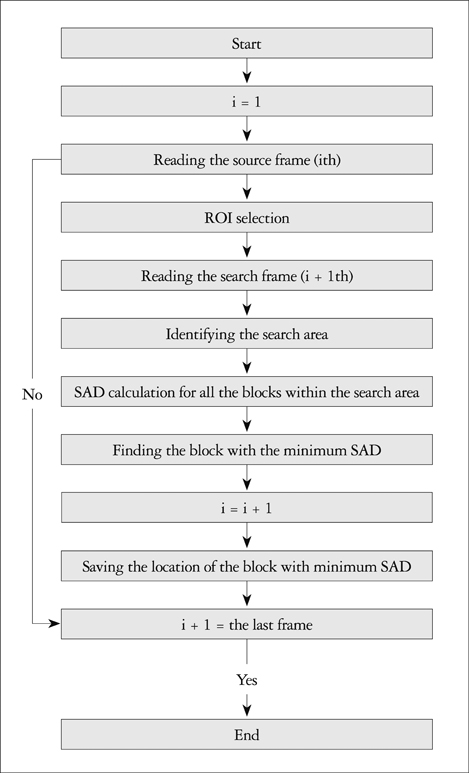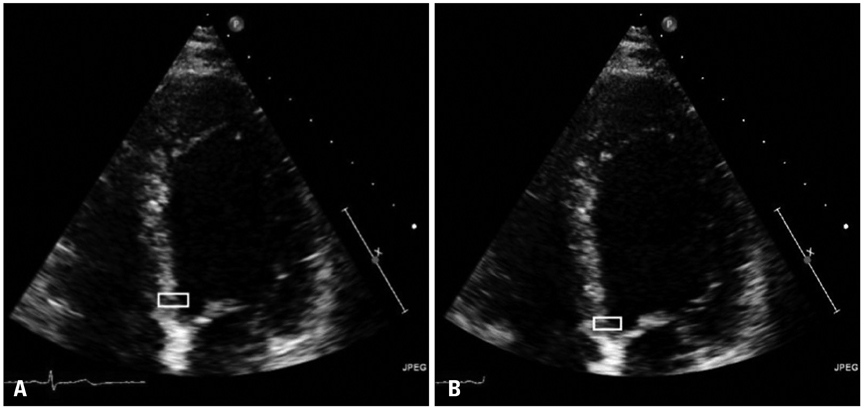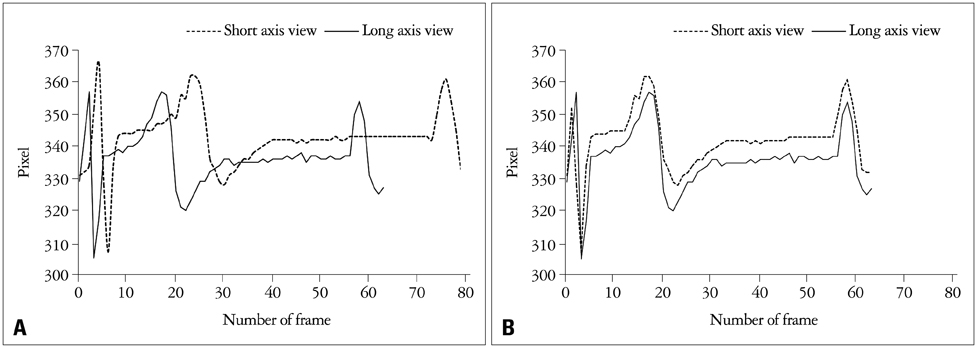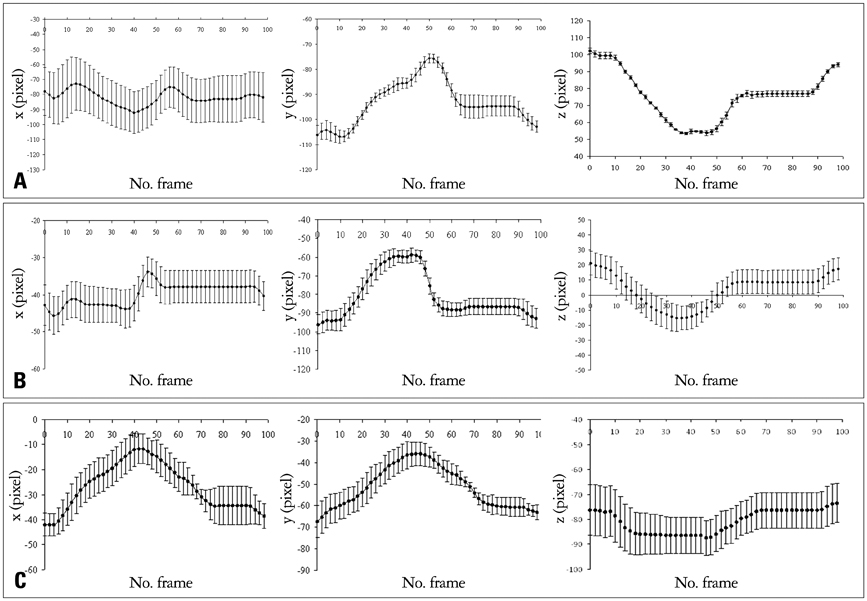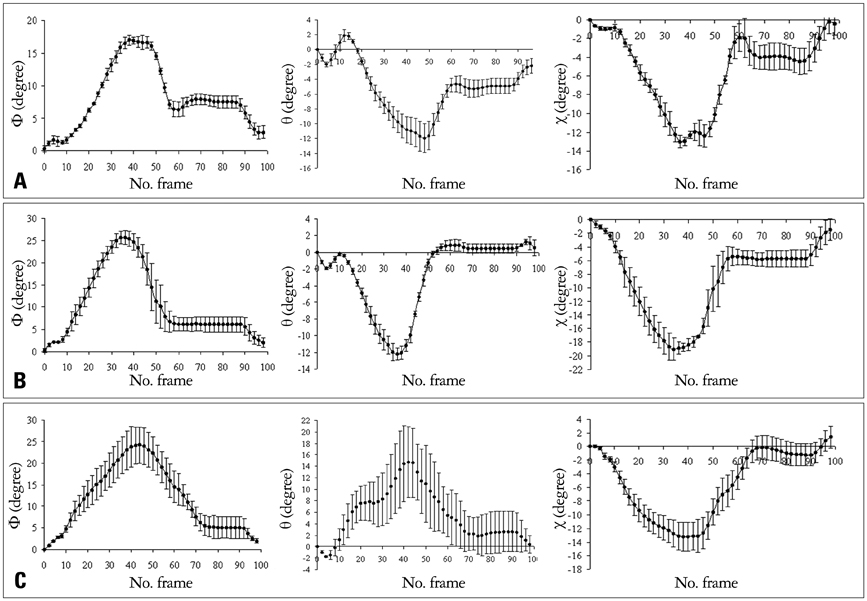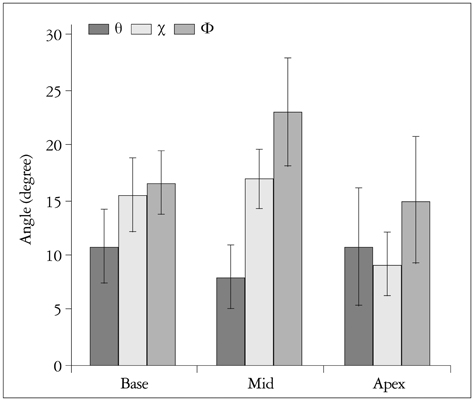J Cardiovasc Ultrasound.
2014 Mar;22(1):14-22. 10.4250/jcu.2014.22.1.14.
Estimating the Myocardium's Angle of Three-Dimensional Trajectory, Using the Tracking of Sequential Two-Dimensional Echocardiography Images
- Affiliations
-
- 1Department of Medical Physics, Faculty of Medical Sciences, Tarbiat Modares University, Tehran, Iran. mokhtarm@modares.ac.ir
- 2Department of Echocardiography, Day General Hospital, Tehran, Iran.
- KMID: 2177451
- DOI: http://doi.org/10.4250/jcu.2014.22.1.14
Abstract
- BACKGROUND
In this study, the angle of the myocardium's trajectory in three dimensions (small ef, Cyrillic) was estimated by simultaneous use of long-axis and short-axis views of left ventricle septum two-dimensional images. Then correlation of three-dimensional trajectory's angle with the rotation angle from the long (chi) and short (theta) axis views was estimated and compared at the three levels of base, mid and apex of the interventricular septum wall.
METHODS
Two-dimensional echocardiography images of long- and short-axis views of 19 healthy men were recorded and analyzed. Using an electrocardiogram of each individual, the images of the two views were synchronized. The interventricular septum wall motion at the three levels of base, mid and apex were estimated, using a block matching algorithm throughout three cardiac cycles. Considering the defined system of coordinates and the position vectors in long and short-axis views, the 3-dimensional angle of the trajectory was calculated.
RESULTS
Maxima of the small ef, Cyrillic, theta, and chi angles were extracted at 16.33 +/- 3.01, 10.61 +/- 3.38, and 15.11 +/- 3.30 degrees at base level, 22.77 +/- 4.95, 7.78 +/- 2.96, and 16.72 +/- 2.66 degrees at mid level and 14.60 +/- 5.81, 10.37 +/- 5.48, and 8.79 +/- 3.32 degrees at apex level, respectively, of the septum wall, respectively. This study shows significant correlation between the angle of 3-dimensional trajectory (small ef, Cyrillic) with the angle in short axis view (theta) of the septum wall at the apex level; and also with the angle in long axis view (chi) of the septum wall at base and mid levels.
CONCLUSION
Due to the motion of the wall of the left ventricle in three dimensions, and the non-isotropic structure of myofibers, the angle of 3-dimensional trajectory was estimated using the speckle tracking method of 2-dimentional echocardiography images.
MeSH Terms
Figure
Reference
-
1. Geyer H, Caracciolo G, Abe H, Wilansky S, Carerj S, Gentile F, Nesser HJ, Khandheria B, Narula J, Sengupta PP. Assessment of myocardial mechanics using speckle tracking echocardiography: fundamentals and clinical applications. J Am Soc Echocardiogr. 2010; 23:351–369. quiz 453-5.
Article2. Taber LA, Yang M, Podszus WW. Mechanics of ventricular torsion. J Biomech. 1996; 29:745–752.
Article3. Sengupta PP, Krishnamoorthy VK, Korinek J, Narula J, Vannan MA, Lester SJ, Tajik JA, Seward JB, Khandheria BK, Belohlavek M. Left ventricular form and function revisited: applied translational science to cardiovascular ultrasound imaging. J Am Soc Echocardiogr. 2007; 20:539–551.
Article4. Torrent-Guasp F, Ballester M, Buckberg GD, Carreras F, Flotats A, Carrió I, Ferreira A, Samuels LE, Narula J. Spatial orientation of the ventricular muscle band: physiologic contribution and surgical implications. J Thorac Cardiovasc Surg. 2001; 122:389–392.
Article5. Nakatani S. Left ventricular rotation and twist: why should we learn? J Cardiovasc Ultrasound. 2011; 19:1–6.
Article6. Buckberg GD. Basic science review: the helix and the heart. J Thorac Cardiovasc Surg. 2002; 124:863–883.
Article7. Sengupta PP, Tajik AJ, Chandrasekaran K, Khandheria BK. Twist mechanics of the left ventricle: principles and application. JACC Cardiovasc Imaging. 2008; 1:366–376.8. Esch BT, Warburton DE. Left ventricular torsion and recoil: implications for exercise performance and cardiovascular disease. J Appl Physiol (1985). 2009; 106:362–369.
Article9. Hansen DE, Daughters GT 2nd, Alderman EL, Stinson EB, Baldwin JC, Miller DC. Effect of acute human cardiac allograft rejection on left ventricular systolic torsion and diastolic recoil measured by intramyocardial markers. Circulation. 1987; 76:998–1008.
Article10. Ingels NB Jr, Daughters GT 2nd, Stinson EB, Alderman EL. Measurement of midwall myocardial dynamics in intact man by radiography of surgically implanted markers. Circulation. 1975; 52:859–867.
Article11. Gustafsson U, Lindqvist P, Mörner S, Waldenström A. Assessment of regional rotation patterns improves the understanding of the systolic and diastolic left ventricular function: an echocardiographic speckle-tracking study in healthy individuals. Eur J Echocardiogr. 2009; 10:56–61.
Article12. Rüssel IK, Götte MJ, Kuijer JP, Marcus JT. Regional assessment of left ventricular torsion by CMR tagging. J Cardiovasc Magn Reson. 2008; 10:26.
Article13. Garot J, Pascal O, Diébold B, Derumeaux G, Gerber BL, Dubois-Randé JL, Lima JA, Guéret P. Alterations of systolic left ventricular twist after acute myocardial infarction. Am J Physiol Heart Circ Physiol. 2002; 282:H357–H362.14. Helle-Valle T, Remme EW, Lyseggen E, Pettersen E, Vartdal T, Opdahl A, Smith HJ, Osman NF, Ihlen H, Edvardsen T, Smiseth OA. Clinical assessment of left ventricular rotation and strain: a novel approach for quantification of function in infarcted myocardium and its border zones. Am J Physiol Heart Circ Physiol. 2009; 297:H257–H267.
Article15. Notomi Y, Lysyansky P, Setser RM, Shiota T, Popović ZB, Martin-Miklovic MG, Weaver JA, Oryszak SJ, Greenberg NL, White RD, Thomas JD. Measurement of ventricular torsion by two-dimensional ultrasound speckle tracking imaging. J Am Coll Cardiol. 2005; 45:2034–2041.
Article16. Arab-Baferani Z, Mokhtari-Dizaji M, Roshanali F. Extraction of left-ventricular torsion angle from the long-axis view by block-matching algorithm: comparison with the short-axis view. Ultrasonics. 2013; 53:552–560.
Article17. Wilson PW, D'Agostino RB, Levy D, Belanger AM, Silbershatz H, Kannel WB. Prediction of coronary heart disease using risk factor categories. Circulation. 1998; 97:1837–1847.
Article18. Cerqueira MD, Weissman NJ, Dilsizian V, Jacobs AK, Kaul S, Laskey WK, Pennell DJ, Rumberger JA, Ryan T, Verani MS. American Heart Association Writing Group on Myocardial Segmentation and Registration for Cardiac Imaging. Standardized myocardial segmentation and nomenclature for tomographic imaging of the heart. A statement for healthcare professionals from the Cardiac Imaging Committee of the Council on Clinical Cardiology of the American Heart Association. Int J Cardiovasc Imaging. 2002; 18:539–542.
Article19. Boukerroui D, Noble JA, Brady M. Velocity estimation in ultrasound images: a block matching approach. Inf Process Med Imaging. 2003; 18:586–598.
Article20. Chen EJ, Jenkins WK, O'Brien WD Jr. The impact of various imaging parameters on ultrasonic displacement and velocity estimates. IEEE Trans Ultrason Ferroelectr Freq Control. 1994; 41:293–301.
Article21. Chadwick RS. Mechanics of the left ventricle. Biophys J. 1982; 39:279–288.
Article22. Arts T, Veenstra PC, Reneman RS. Epicardial deformation and left ventricular wall mechanisms during ejection in the dog. Am J Physiol. 1982; 243:H379–H390.
Article23. Guccione JM, Moonly SM, Moustakidis P, Costa KD, Moulton MJ, Ratcliffe MB, Pasque MK. Mechanism underlying mechanical dysfunction in the border zone of left ventricular aneurysm: a finite element model study. Ann Thorac Surg. 2001; 71:654–662.
Article24. Guccione JM, Moonly SM, Wallace AW, Ratcliffe MB. Residual stress produced by ventricular volume reduction surgery has little effect on ventricular function and mechanics: a finite element model study. J Thorac Cardiovasc Surg. 2001; 122:592–599.
Article25. Yeung F, Levinson SF, Fu D, Parker KJ. Feature-adaptive motion tracking of ultrasound image sequences using a deformable mesh. IEEE Trans Med Imaging. 1998; 17:945–956.
Article26. Urbano Moral JA, Arias Godinez JA, Maron MS, Malik R, Eagan JE, Patel AR, Pandian NG. Left ventricular twist mechanics in hypertrophic cardiomyopathy assessed by three-dimensional speckle tracking echocardiography. Am J Cardiol. 2011; 108:1788–1795.
Article
- Full Text Links
- Actions
-
Cited
- CITED
-
- Close
- Share
- Similar articles
-
- Current Status of 3-Dimensional Speckle Tracking Echocardiography: A Review from Our Experiences
- Clinical Applications of Three-Dimensional Echocardiography
- Echocardiographic Findings of Heart Disease in Children
- Horseshoe-like Shaped Atrial Septal Defects Confirmed on Three-Dimensional Transesophageal Echocardiography
- Real-time Three Dimensional Echocardiography Clinical Implications and The Perspective

